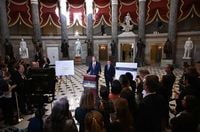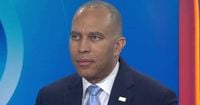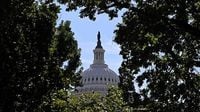The United States federal government shutdown, which began on October 1, 2025, has entered its sixth day with no sign of resolution in sight. As the days drag on, the effects of the impasse in Washington are rippling far beyond the halls of Congress, touching the lives of hundreds of thousands of federal workers, ordinary citizens, and the broader economy. The current crisis underscores the persistent fragility of U.S. budgetary politics, as deep partisan divisions once again prevent Congress from passing a funding bill to keep the government running.
President Donald Trump, speaking to reporters on October 5, 2025, made it clear who he believes is to blame. "It's taking place right now and it's all because of the Democrats," Trump said, referring to the layoffs of federal workers that are reportedly underway. "The Democrats are causing the loss of a lot of jobs," he added, though he declined to specify which agencies were affected. Trump’s administration, according to White House National Economic Council Director Kevin Hassett, is preparing for mass layoffs if negotiations with congressional Democrats remain stalled. "President Trump and Russ Vought are lining things up and getting ready to act if they have to, but hoping that they don’t," Hassett told CNN’s State of the Union. "If the president decides that the negotiations are absolutely going nowhere, then there will start to be layoffs."
While Trump and his team have positioned the layoffs as a consequence of Democratic intransigence, Democrats see things differently. House Democratic leader Hakeem Jeffries lamented on October 5 that there had been no talks with Republican leaders since a White House meeting nearly a week earlier. "And, unfortunately, since that point in time, Republicans, including Donald Trump, have gone radio silent," Jeffries said. "And what we've seen is negotiation through deepfake videos, the House canceling votes, and of course President Trump spending yesterday on the golf course. That's not responsible behavior."
The standoff centers on two key issues: Democrats are demanding the renewal of subsidies to cover health insurance costs for millions of households, while Trump insists on preserving existing spending levels and seems to believe that Democrats will eventually yield due to the mounting risks to jobs and federal projects. As both sides dig in, the stakes are rising. According to the Congressional Budget Office, nearly 750,000 federal employees face being furloughed as long as the shutdown continues, with total lost compensation estimated at $400 million per day. Though federal workers are guaranteed backpay under the 2019 Government Employee Fair Treatment Act, those payments will only resume once the shutdown ends.
For many federal employees, the financial insecurity is immediate and severe. Past surveys have shown that nearly 80 percent of federal workers live paycheck to paycheck, meaning even a brief disruption can force them into debt or cause them to delay paying bills. The shutdown’s impact doesn’t stop there. Essential public services—passport offices, tax refund processing, and national parks—face delays or closures, inconveniencing citizens who rely on government efficiency for everyday tasks. The suspension of statistical agencies also introduces complications for financial markets and policymakers. For example, delays in employment figures or inflation statistics, which the Federal Reserve uses to guide interest rate decisions, could have consequences for the broader economy.
Republican leaders, for their part, have expressed regret over the possibility of layoffs but maintain that the administration is left with little choice. House Speaker Mike Johnson said on NBC, "We haven't seen the details yet about what's happening with layoffs. But it is a regrettable situation that the president does not want." Kevin Hassett echoed this sentiment, stating, "We want the Democrats to come forward and to make a deal that's a clean, continuing resolution that gives us seven more weeks to talk about these things. But the bottom line is that with Republicans in control, the Republicans have a lot more power over the outcome than the Democrats."
Senate Democratic leaders remain steadfast in their demands. Senator Adam Schiff of California defended the party’s stance, arguing that the possible increase in health care costs for "millions of Americans" would make insurance unaffordable in what he called a "crisis." Schiff also pointed out that the Trump administration has stopped congressionally approved spending from being used, undermining the value of any budget compromise. "We need both to address the health care crisis and we need some written assurance in the law—I won't take a promise—that they're not going to renege on any deal we make," Schiff said.
The Senate has attempted to break the deadlock, but with little success. On October 3, a vote to advance a Republican bill to reopen the government failed to reach the 60 votes needed to end a filibuster. Senate Majority Leader John Thune said on Fox News Channel’s Sunday Morning Futures, "They'll get another chance on Monday to vote again. And I'm hoping that some of them have a change of heart." But optimism is in short supply. Democratic Senator Ruben Gallego told CNN, "At this point, no," when asked if lawmakers were closer to a deal.
The roots of the shutdown run deep. Since the modern budget process was established in 1976, the federal government has experienced more than 20 funding gaps, each a product of the American system of checks and balances. These shutdowns, while reflecting democratic contestation, carry real-world costs. The 35-day shutdown of 2018-2019, the longest in U.S. history, furloughed around 800,000 federal workers and shaved an estimated $11 billion off U.S. GDP, nearly $3 billion of which was never recovered, according to the Congressional Budget Office.
Beyond the numbers, the repeated spectacle of shutdowns has eroded public trust in government. After the 2019 shutdown, a Pew Research Center survey found that two-thirds of Americans had low confidence in the federal government. The current impasse threatens to deepen that disillusionment. For many, the shutdown is more than a political drama—it’s a disruption of daily life, a source of anxiety for families unsure when their next paycheck will arrive, and a test of the nation’s ability to provide basic services.
The implications stretch beyond U.S. borders. Allies and rivals alike watch as the world’s largest economy struggles to keep its government open, raising questions about Washington’s reliability as a global partner. Other advanced economies, while not immune to political strife, rarely experience such extreme disruptions in government functioning. During the eurozone crisis or the COVID-19 pandemic, European states endured severe economic stress but did not suspend public services due to legislative deadlock.
As the shutdown grinds on, the challenge for U.S. policymakers is clear: reconcile the demands of political debate with the responsibility of governance. The cost of failure is not just measured in dollars lost or services delayed, but in the erosion of faith that government can deliver stability and continuity for its citizens. With both sides entrenched and negotiations at a standstill, the path forward remains uncertain, leaving federal workers and the public caught in the crossfire.


